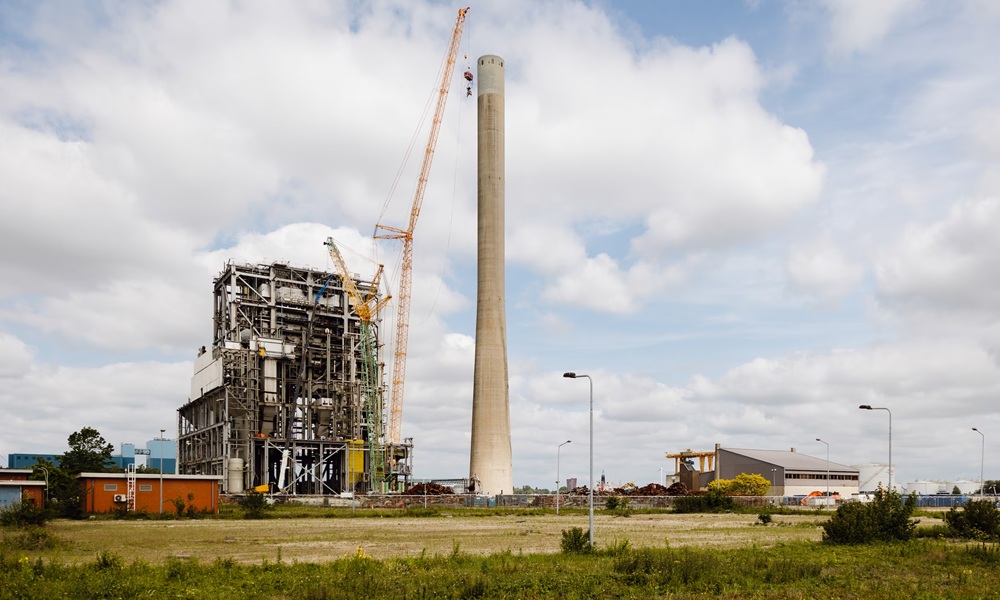A Tadano CC 38.650-1 lattice-boom crawler crane has played a central role in the dismantling of a 175-metre stack at a former coal-fired power plant in Amsterdam’s port zone, completing one of the final phases of the site’s decommissioning. Crane service provider Sarens was contracted for the specialist lift by demolition consortium Combinatie ACGH, comprising LEK Sloopwerken, Vermeulen Sloop en Milieutechniek and MNE Sloop & Demontage.
The assignment required the crane to hoist a hydraulic demolition robot — including interchangeable shear and breaker attachments — to the top of the stack and lower it progressively as work descended. The tools were repeatedly swapped throughout the process, demanding precise control at extreme height and a configuration capable of reaching 196 metres with sufficient lifting capacity.
Custom configuration engineered for the lift
The required setup exceeded the standard configurations listed in the CC 38.650-1 load charts. Sarens therefore worked with Tadano engineers to validate a special SWSL_3 configuration combining a 108-metre main boom with an 84-metre Boom Booster and a 90-metre luffing jib. Tadano extended the load charts and updated the crane’s LMI system to reflect the bespoke arrangement.
“The support from the manufacturer was absolutely vital for us, since the required crane configuration had never been put together before,” said Sarens Lifting Supervisor Jerry Couvreur. Tadano also supplied on-site technical support from personnel in the Netherlands and Germany throughout the operation.
The crane was configured with 225 tonnes of superstructure counterweight, 50 tonnes of central ballast, and 245 tonnes of SL counterweight. Sarens used two types of hook blocks — one three-part and one single-reeved — to optimise hoisting speed and reduce non-productive time when swapping demolition tools.
Logistics, setup and safety
Transporting the crane from Sarens’ Wolvertem headquarters required more than 50 truck movements over four days. Assembly was completed in five days by three installation technicians and additional crane operators as needed. After rigging, the team installed multiple cameras on the jib tip and a cab-mounted monitor to maximise operator visibility during demolition.
Safety planning was extensive. The team positioned a double line of containers in front of the crane to shield it from falling debris and fitted the crane cab with transparent protection. Wind analysis played a major role in positioning the crane to ensure prevailing winds would carry falling rubble away from operating personnel. Work ceased whenever wind direction or speed fell outside safety parameters.
The boom-lowering procedure required additional attention due to the anti-dust spray system mounted on the boom — a component that increased the risk of collision during raising and lowering.
Demolition delivered on time
With an ambitious target of five metres of demolition per day, the team worked in two shifts, often running the crane for 16 hours daily across a ten-week period. The crane advanced around the circumference of the stack in a circular sequence, with a lifting supervisor and operator coordinating closely on every lift.
Despite the complexity, constraints and the unprecedented configuration, the Tadano CC 38.650-1 maintained consistent performance throughout, enabling Sarens to complete the demolition on schedule and remove one of the last remaining structures of the Hemweg 8 coal-fired power plant.
